Securing the border with Mexico
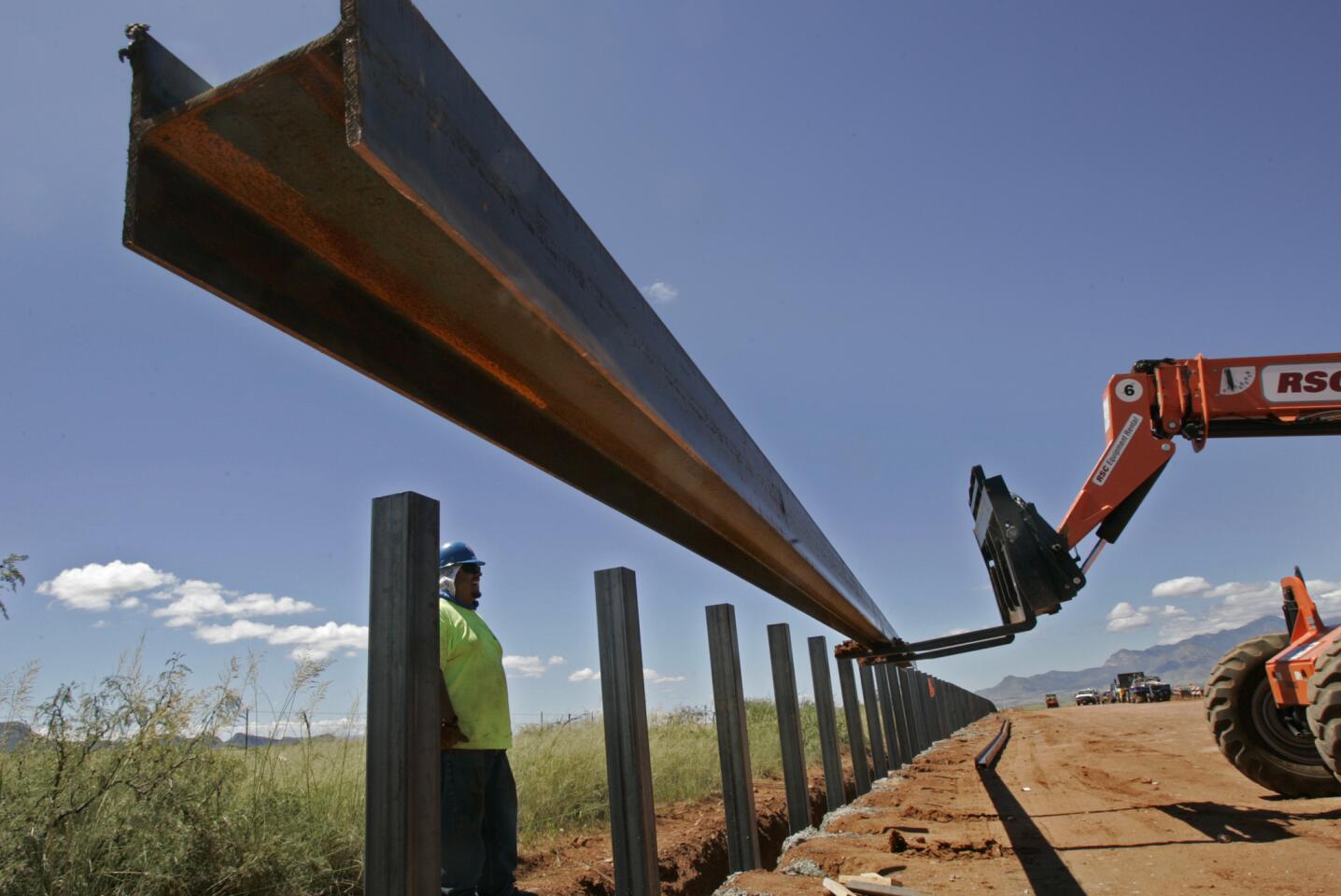
Sept. 11, 2007: A steel rail is lifted into position on the new U.S.-Mexico border fence outside of Naco, Ariz. (Don Bartletti / Los Angeles Times)
Despite barriers, migrants are still getting across, although the flow has slowed. The debate now is whether the government can do more, and pay for it.
Immigration reform’s first hurdle: Is the border secure?
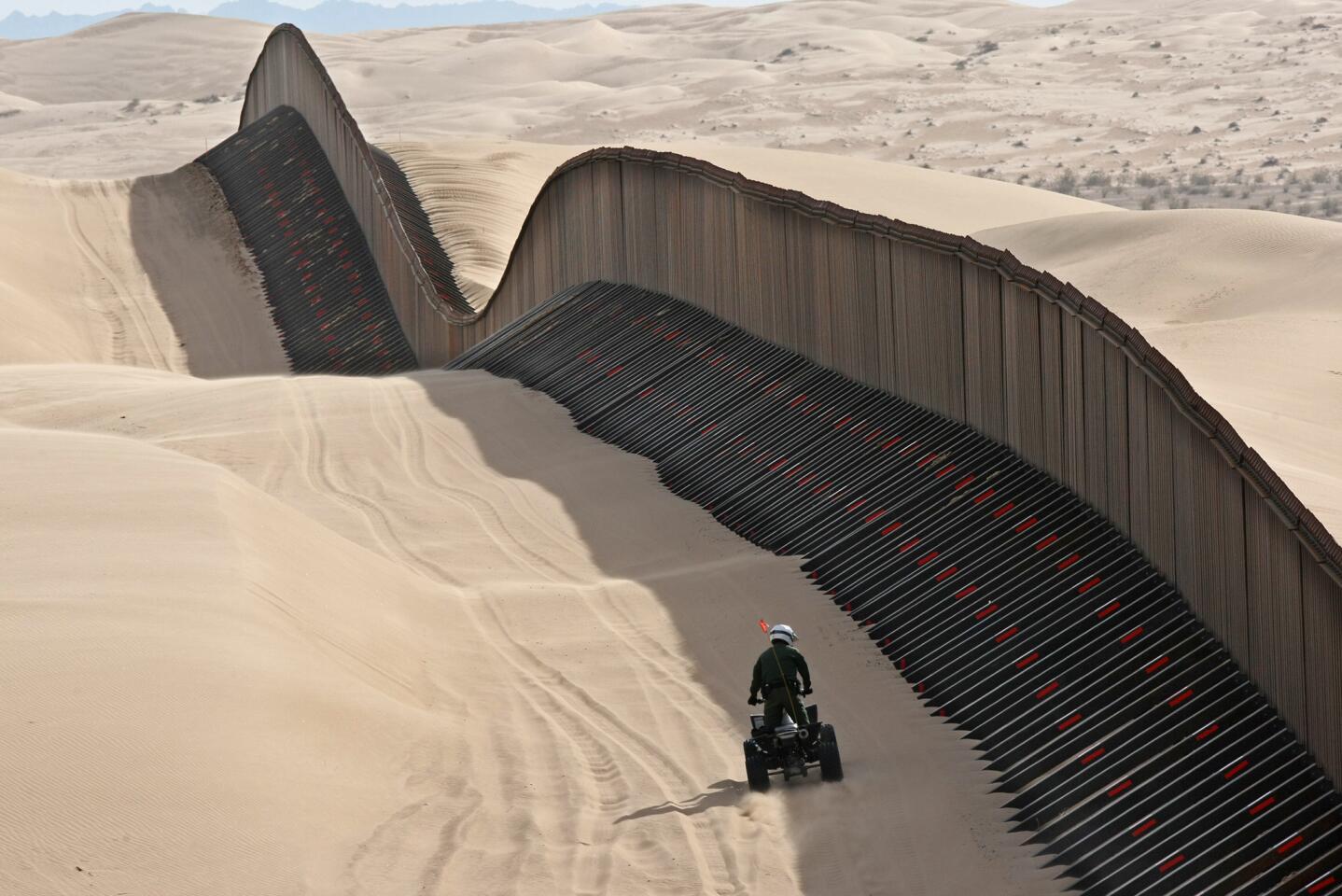
March 4, 2009: A U.S. Border Patrol agent inspects the “floating fence” that sits atop the powdery Imperial Sand Dunes in California. Angled buttresses on either side give the fence stability atop the wind-blown sand. (Don Bartletti / Los Angeles Times)
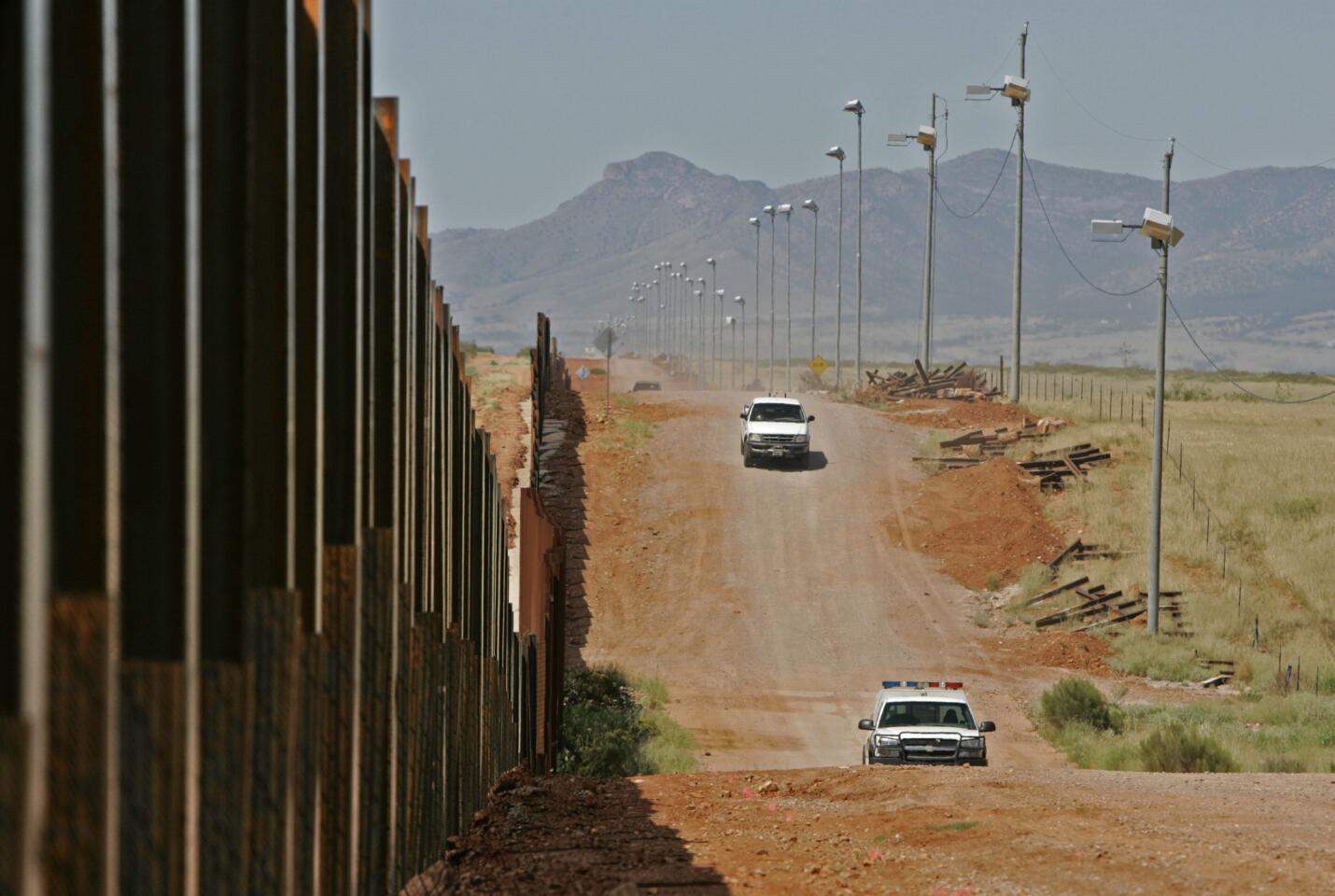
Sept. 11, 2007: The Border Patrol and local ranchers in Naco, Ariz., drive along a gravel road lined with high-intensity security lights, cameras and the new 15-foot-high fence. (Don Bartletti / Los Angeles Times)
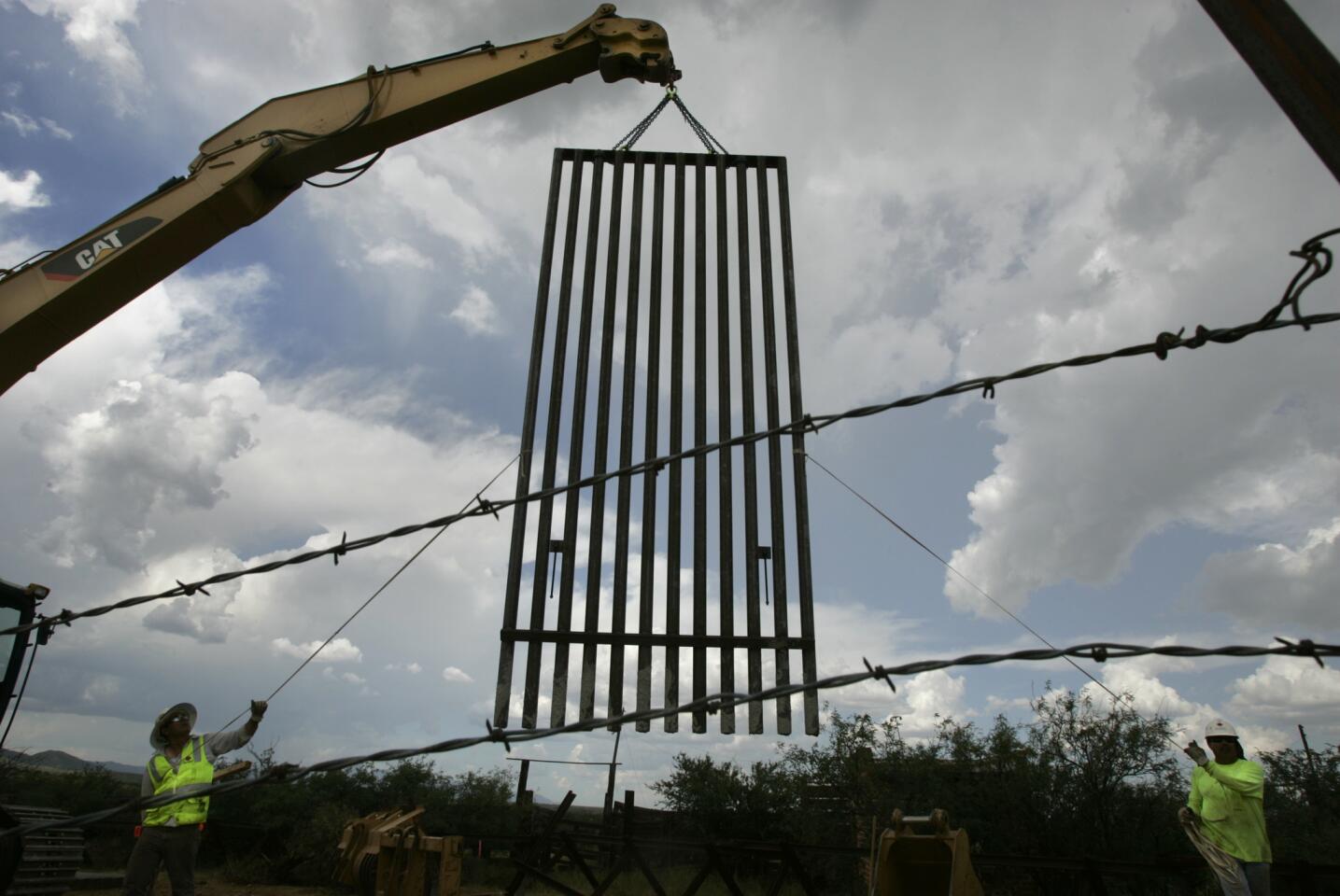
Sept. 12, 2007: Another 15-foot-high fence section is lifted into place near the Sasabe, Ariz., Port of Entry. (Don Bartletti / Los Angeles Times)
Advertisement
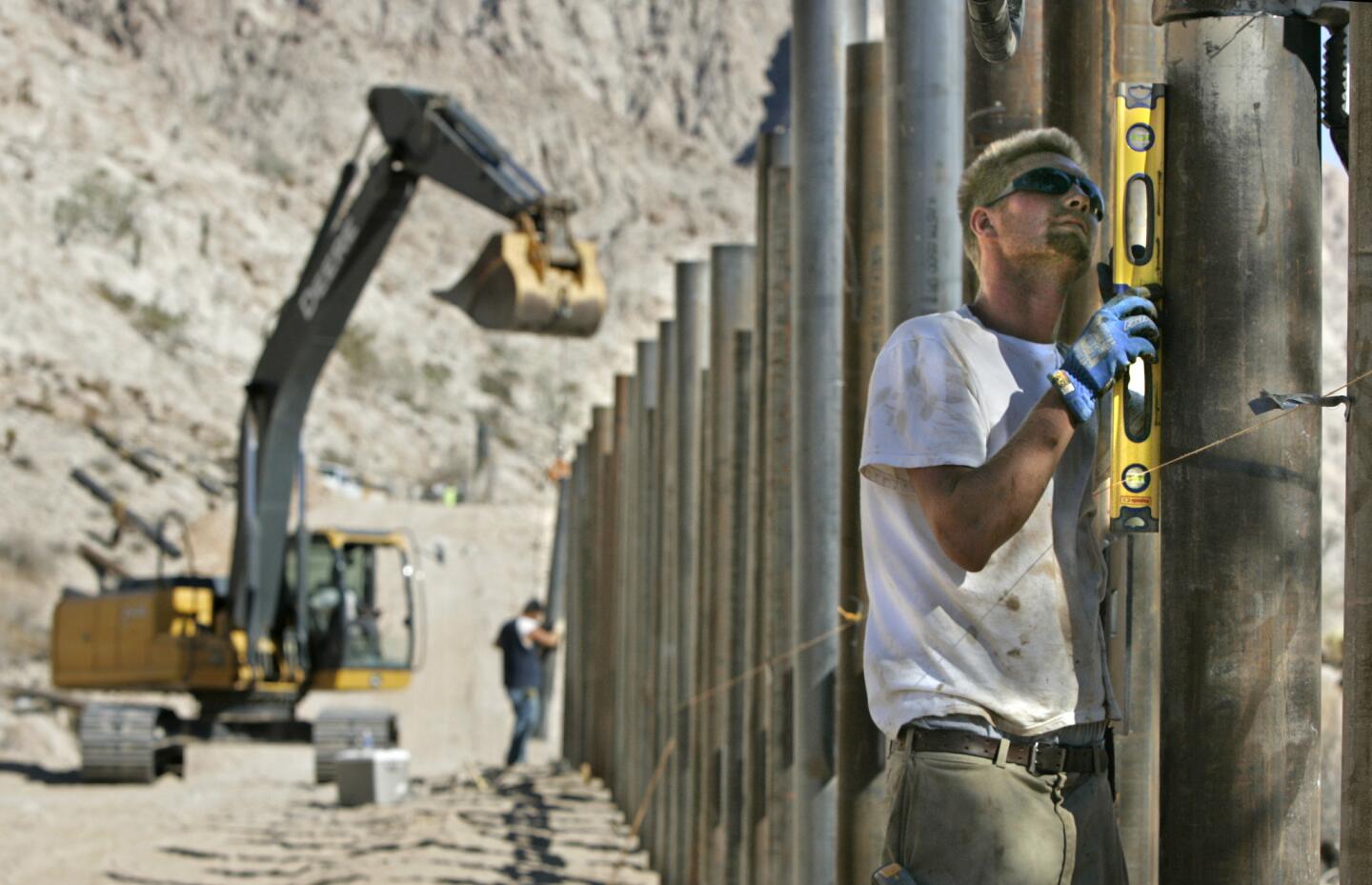
Sept. 19, 2007: Forty miles into the desert east of San Luis, Ariz., Dan Anskate checks the level of a 12-inch-diameter steel fence post. All new fences along the border must be able to withstand a 40-mph impact from a vehicle. (Don Bartletti / Los Angeles Times)
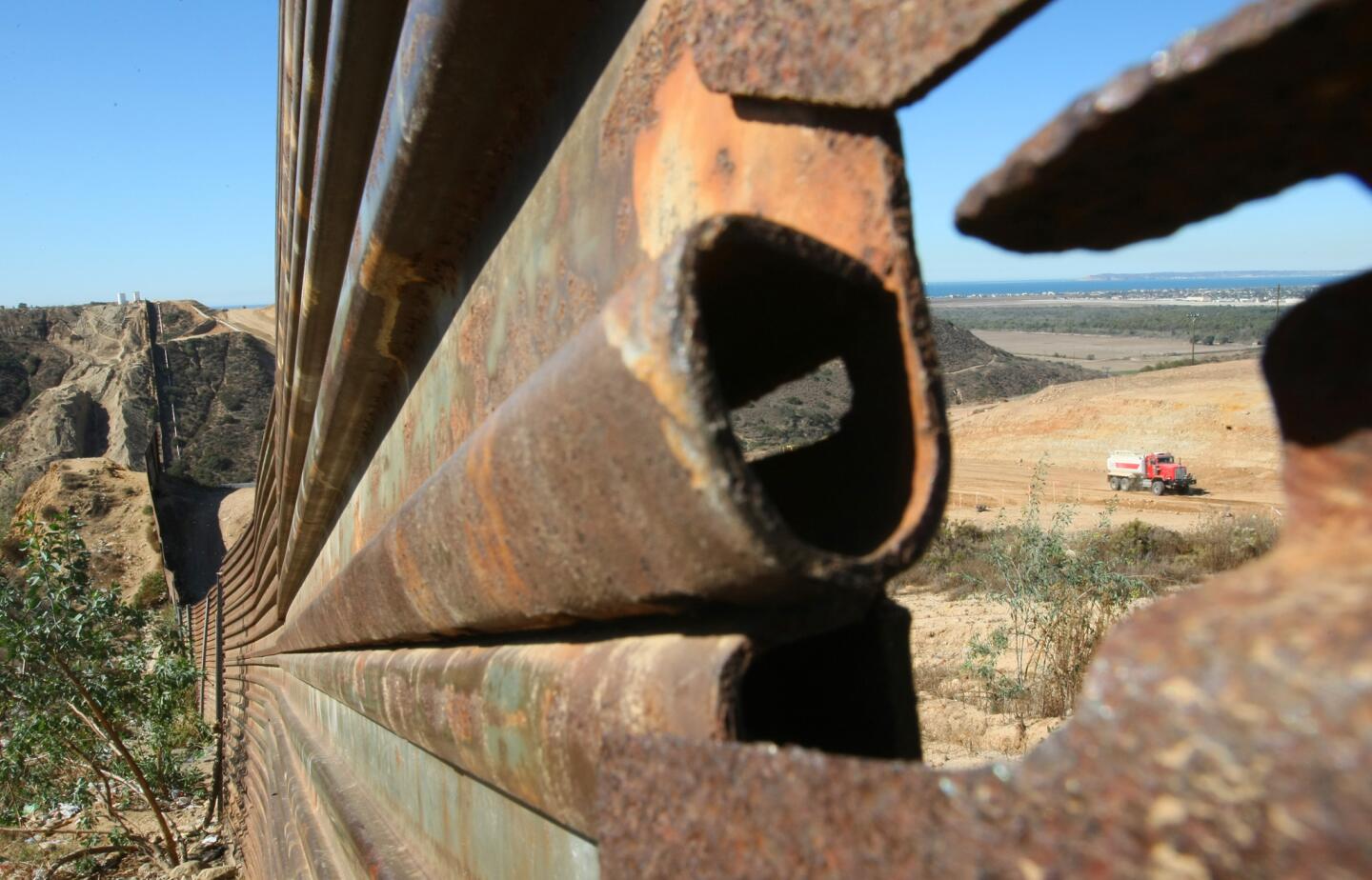
Nov. 21, 2008: Through a small gap in the rusty border fence at Tijuana, a new all-weather road can be seen under construction a short distance to the north. (Don Bartletti / Los Angeles Times)
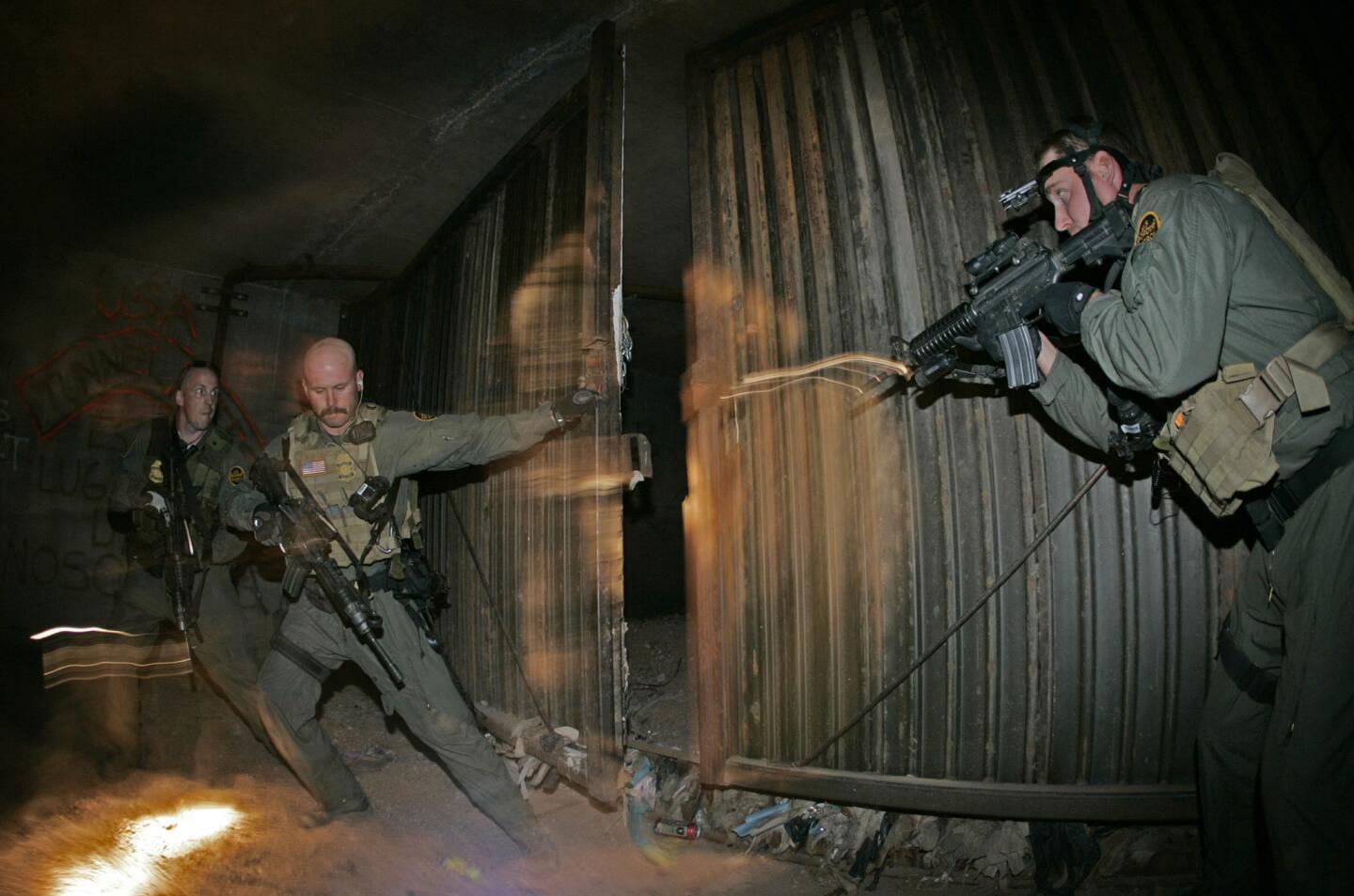
Dec 14, 2005: Searching for smugglers a mile inside a drainage tunnel in Nogales, Ariz., Border Patrol agents yank open a steel gate that defines the U.S.-Mexico border. (Don Bartletti / Los Angeles Times)
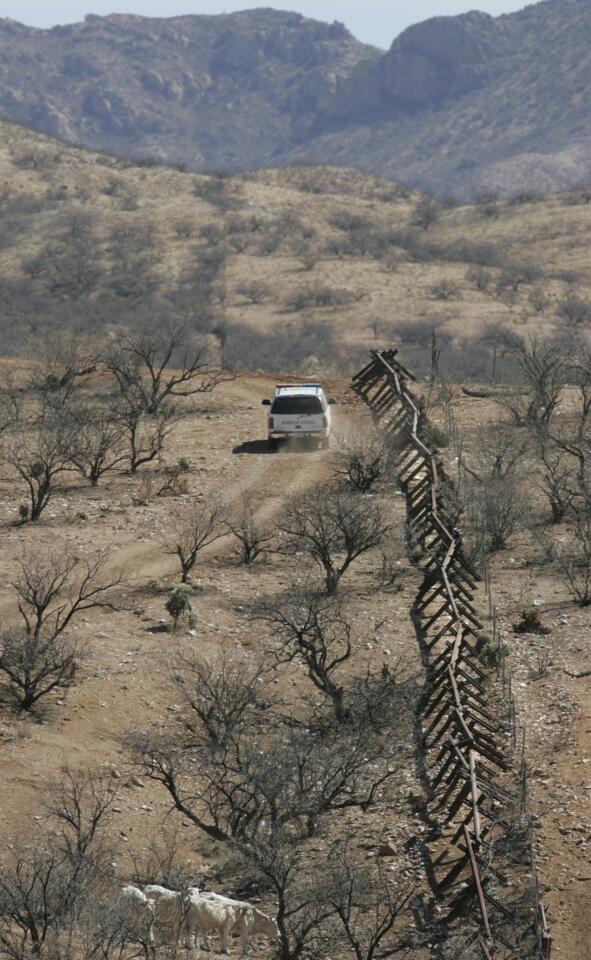
Feb. 28, 2007: A U.S. Border Patrol agent follows a vehicle barrier that defines the border to about four miles east of Sasabe, Ariz. Farther east there is no border barrier, but agents observe the remote desert area with aerial drones and ground sensors. (Don Bartletti / Los Angeles Times)
Advertisement
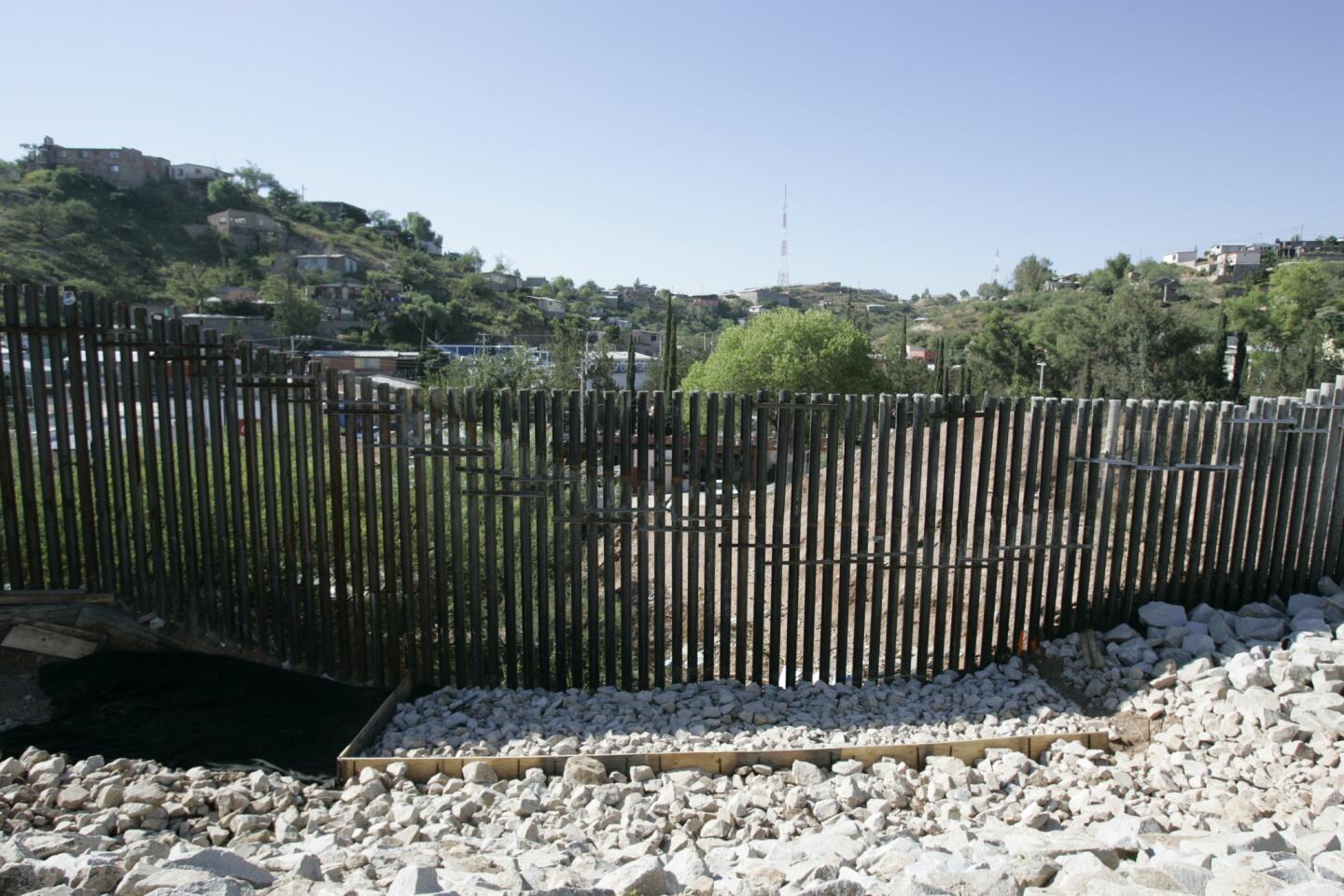
Sept. 13, 2007: Tall steel tubes make up the border fence where it spans an intermittent water flow area between Nogales, Ariz., and Nogales, Sonora, Mexico. (Don Bartletti / Los Angeles Times)
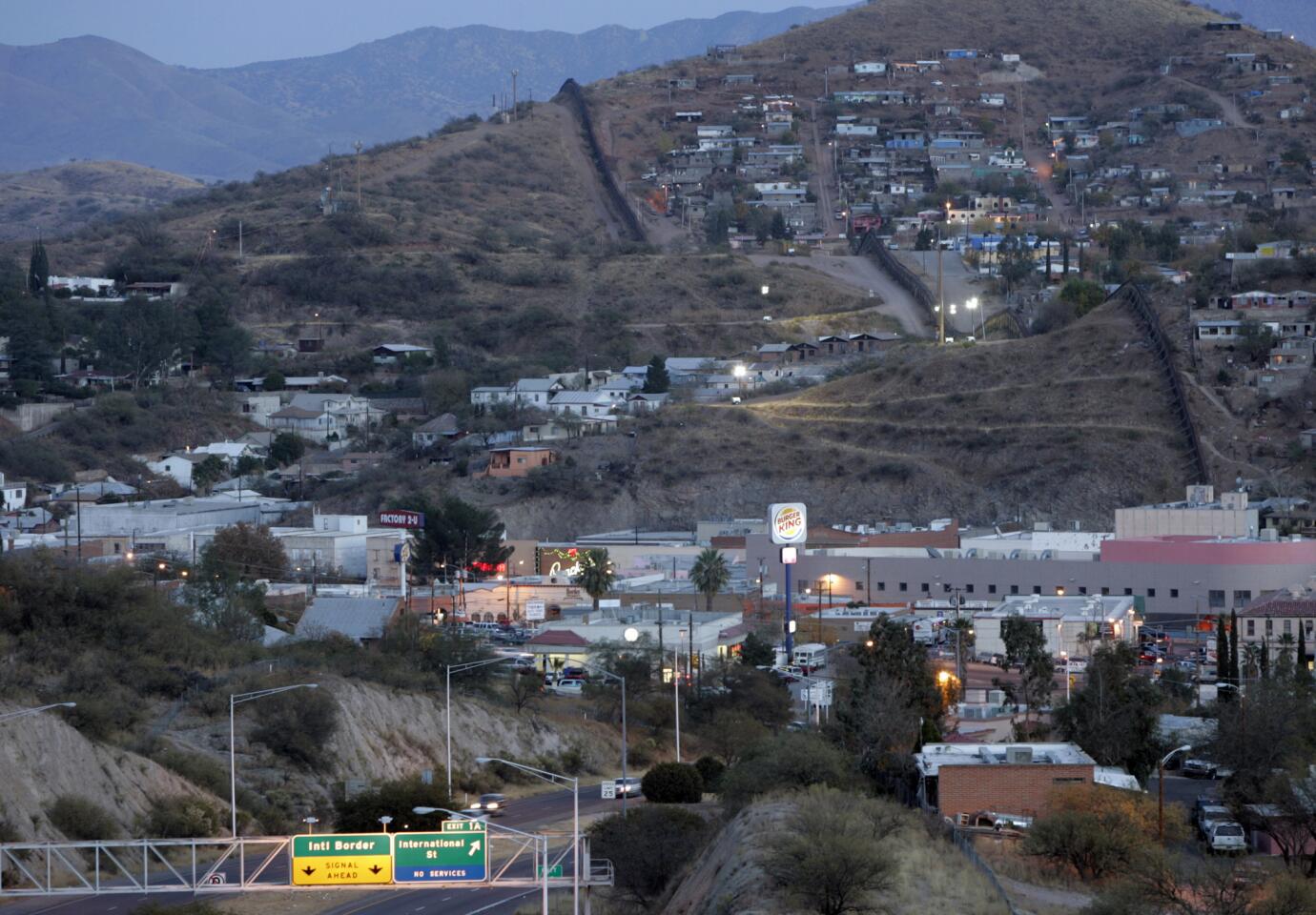
Dec. 14, 2005: Businesses line Grand Avenue in Nogales, Ariz., which proceeds to the border outside the photo at right. Beneath the pavement is a huge drainage tunnel used by Mexican smugglers to sneak into the U.S. (Don Bartletti / Los Angeles Times)
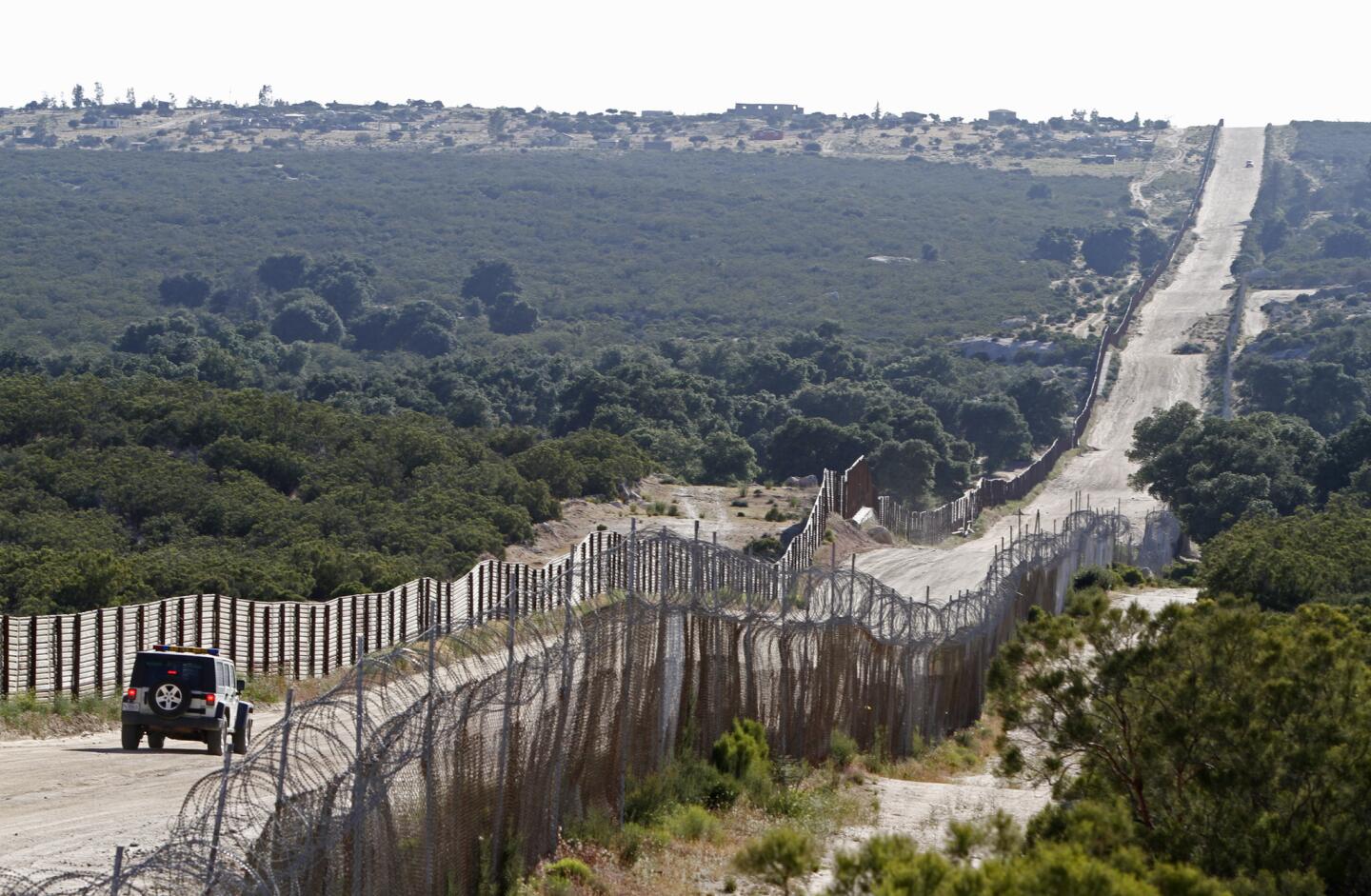
May 27, 2010: In Tierra Del Sol, Calif., a U.S. Border Patrol jeep drives slowly along a dirt road between the steel border fence and rancher Bob Maupin’s makeshift chain-link and razor-wire barrier. Until the official fence was erected and patrols were increased here, about 65 miles east of San Diego, Maupin’s property was a popular route for northbound illegal immigrants and drug smugglers. (Don Bartletti / Los Angeles Times)
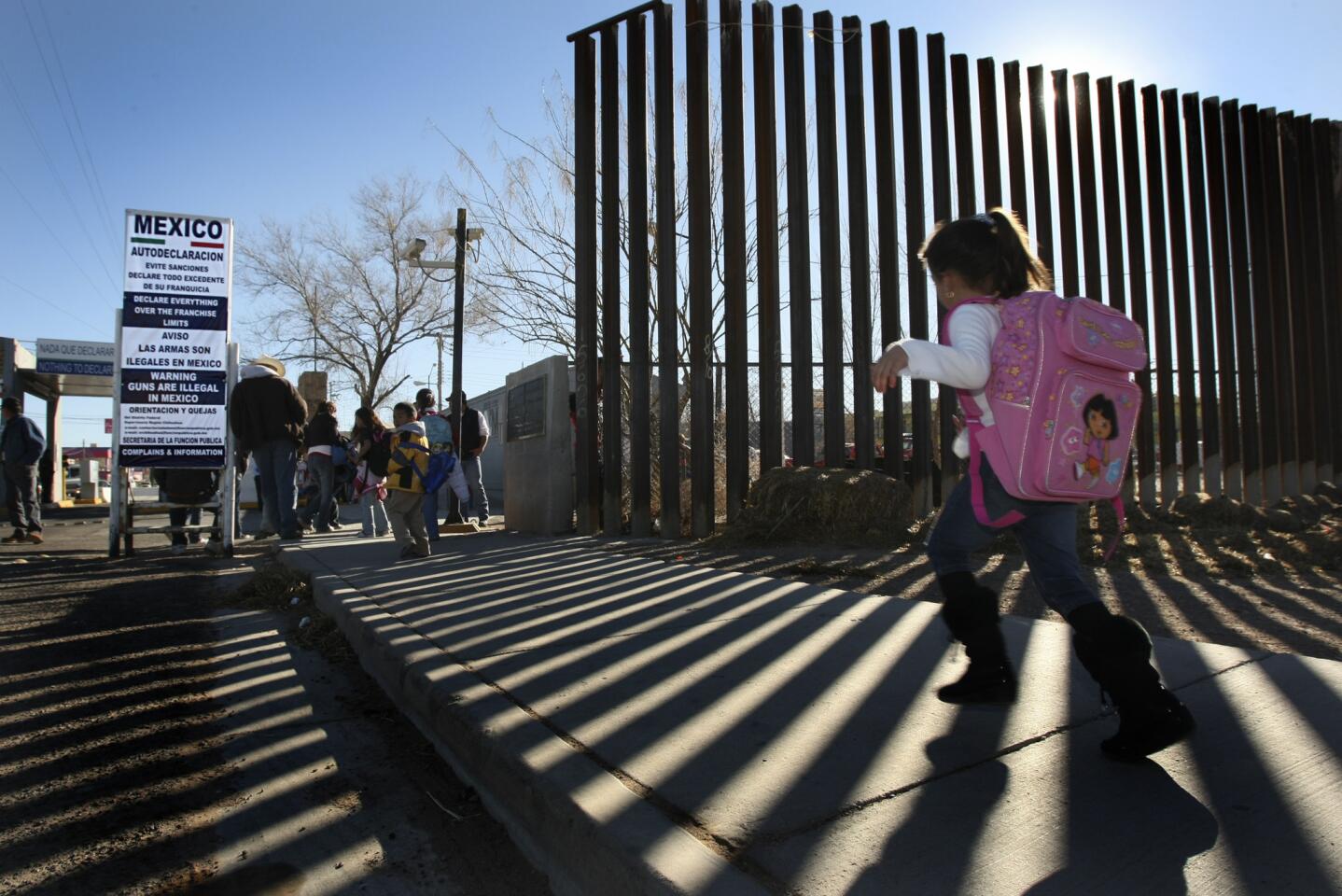
Jan. 15, 2009: A student who is an American citizen runs toward the border gate at Columbus, N.M. About 300 students who live in Palomas, Mexico, attend school on the U.S. side. A sign at the pedestrian gate warns: “Guns are illegal in Mexico.” (Don Bartletti / Los Angeles Times)
Advertisement
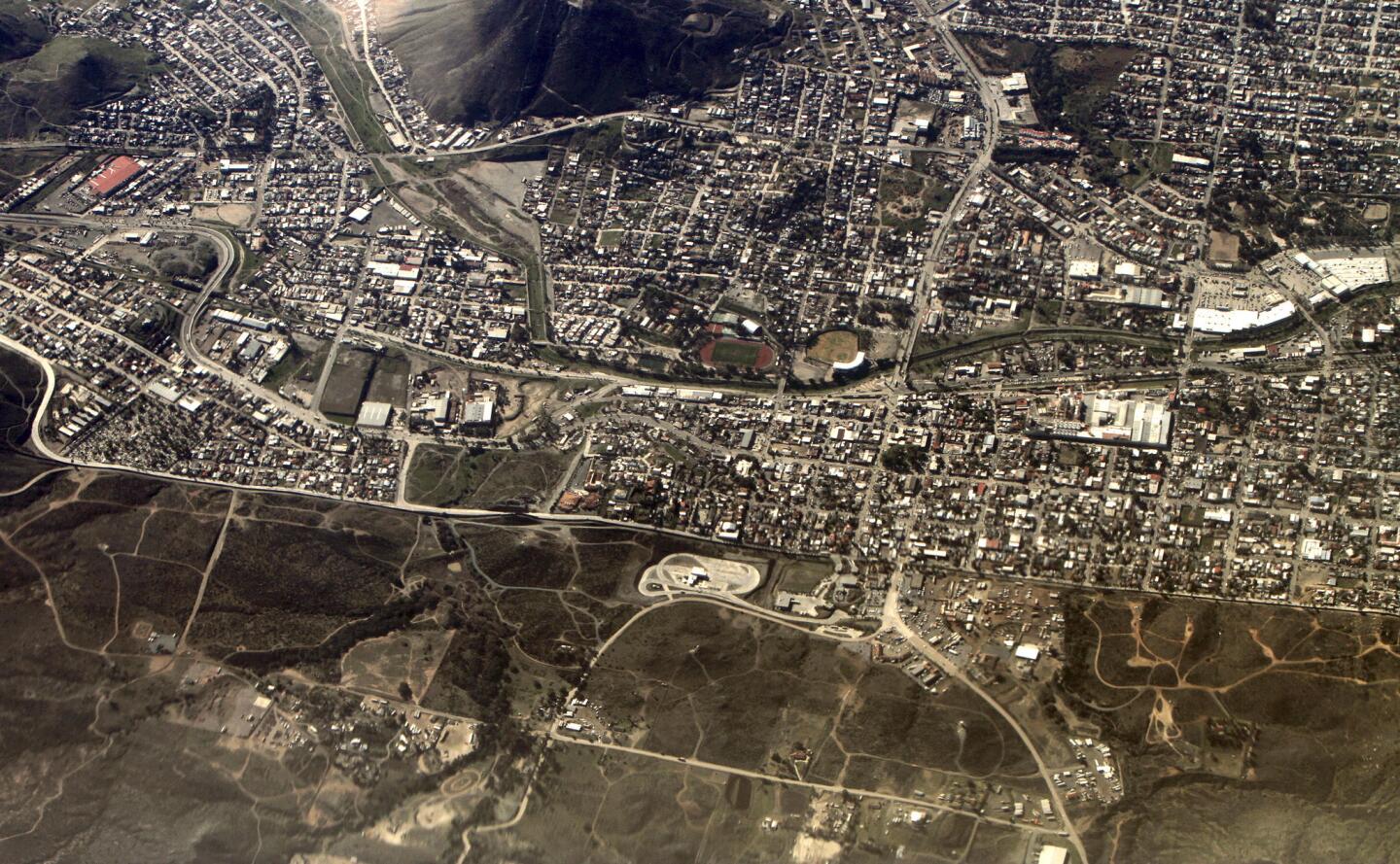
Feb. 22, 2013: In this aerial photo, the border line bisects the city of Tecate, Mexico, at the top and tiny Tecate, Calif., at the bottom. (Don Bartletti / Los Angeles Times)
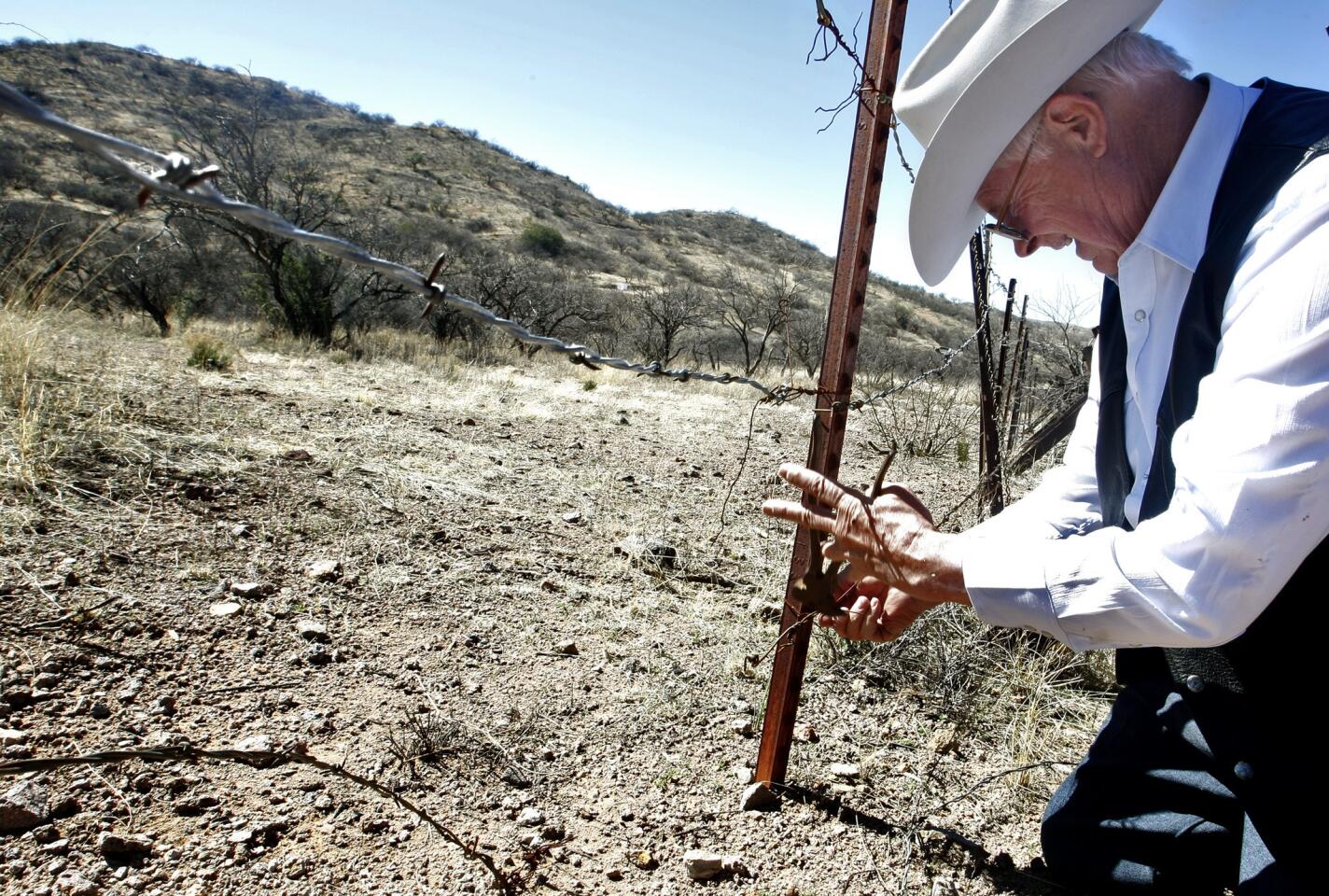
Feb. 22, 2013: Cattle rancher Jim Chilton repairs the barbed-wire fence where his ranch shares the border with Mexico about 19 miles south of Arivaca, Ariz. Cartel drug runners and illegal migrants cut the wire almost every day. (Don Bartletti / Los Angeles Times)
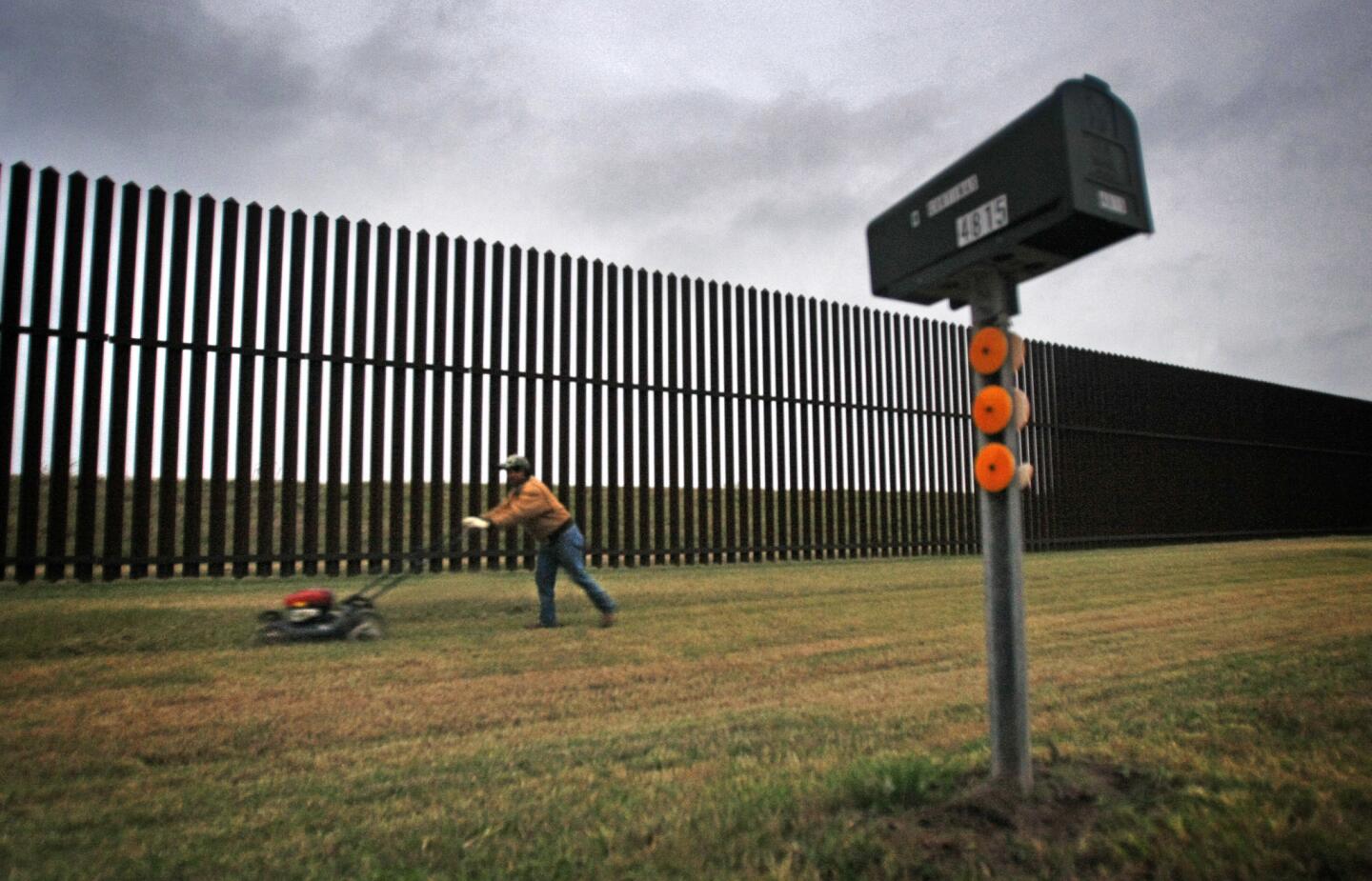
Jan. 20, 2011: A resident east of Brownsville, Texas, mows grass along the border fence that’s hundreds of yards north of the U.S.-Mexico border line. Because of the meandering course of the Rio Grande and its flood plain, in some places the fence cuts through agricultural fields and neighborhoods. (Don Bartletti / Los Angeles Times)
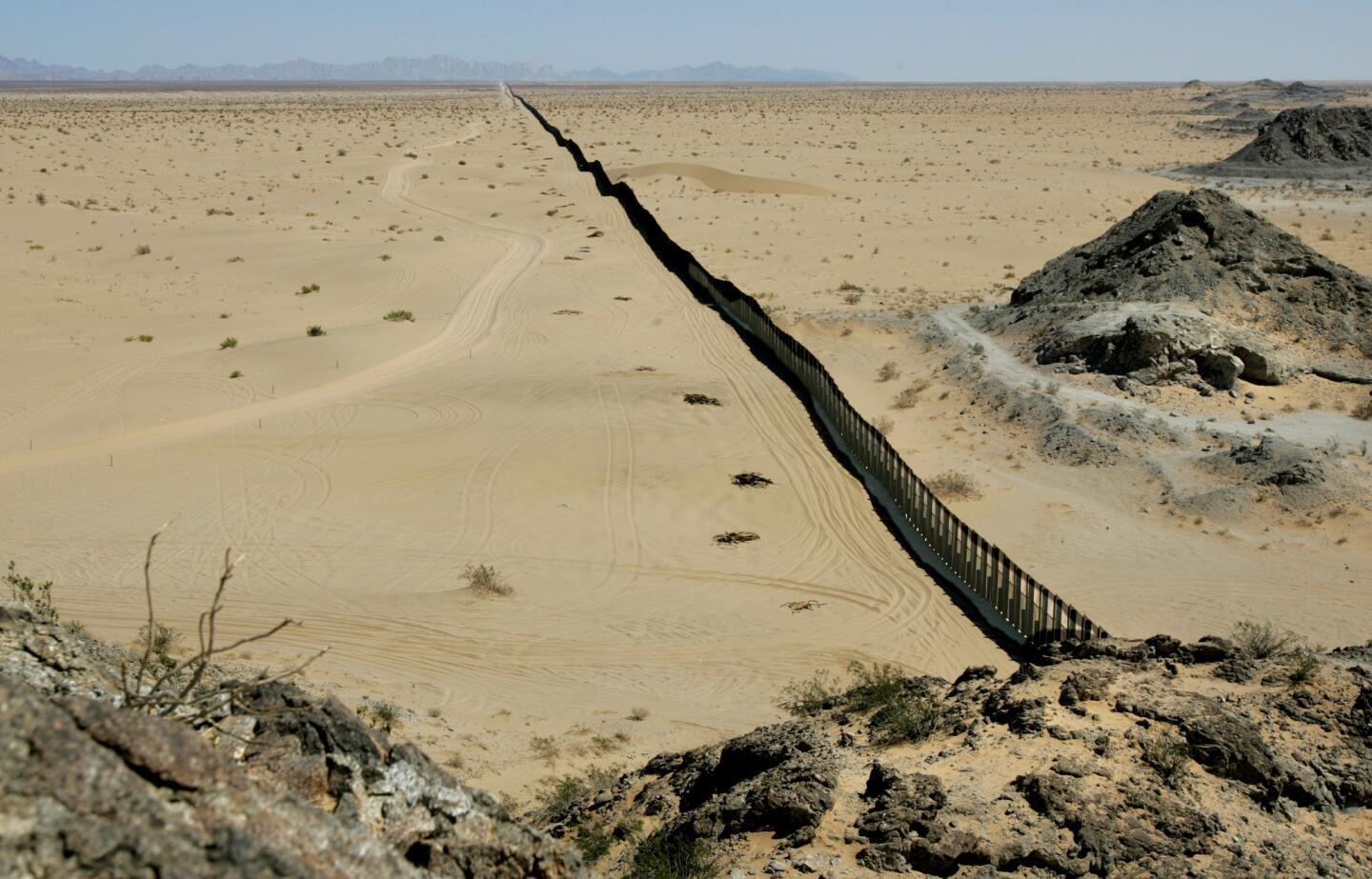
Sept. 19, 2007: This barrier stretches about 32 miles along the desert border line east of San Luis, Ariz. The Mexican state of Sonora is on the right. (Don Bartletti / Los Angeles Times)
Advertisement
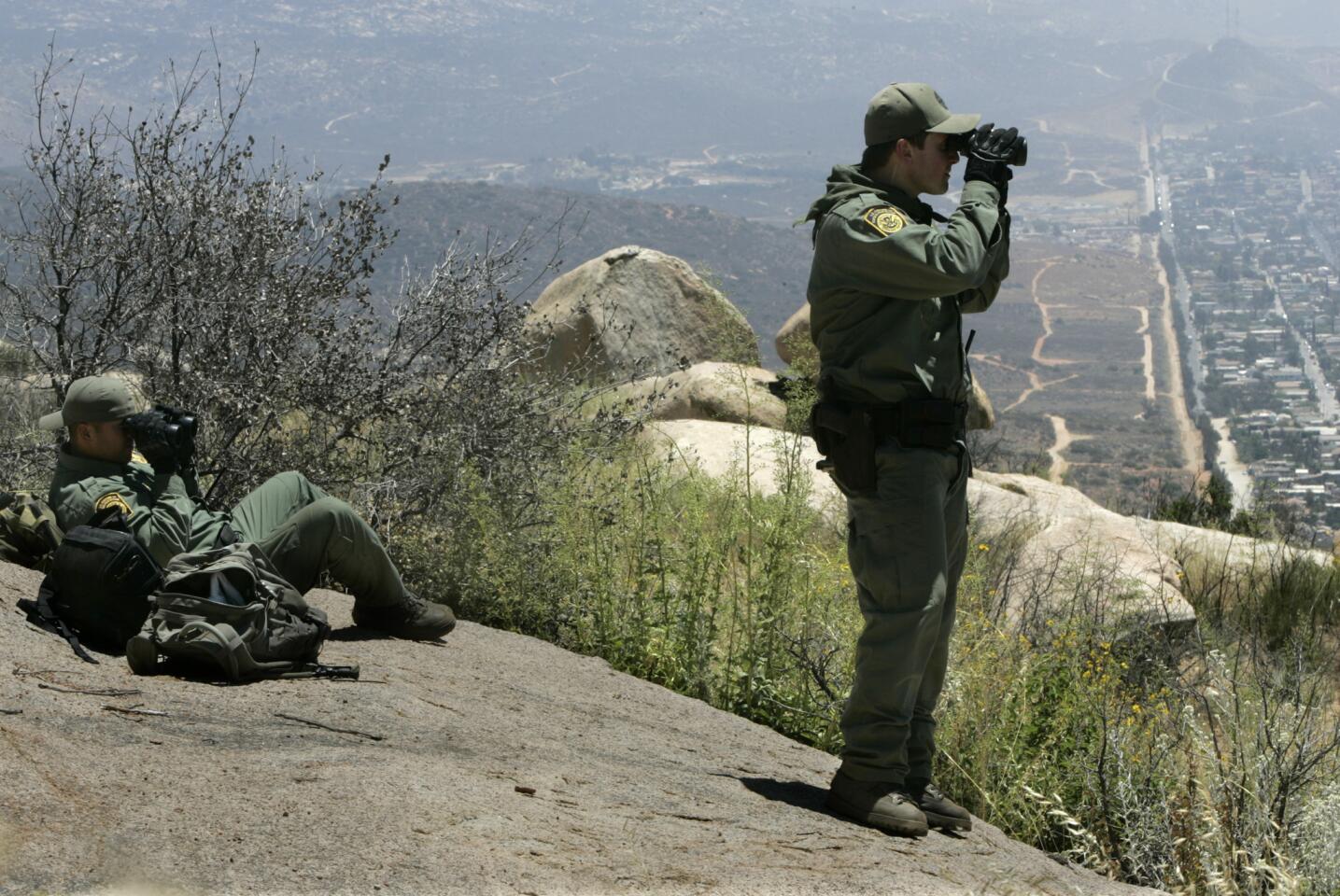
June 18, 2007: From Tecate Peak in California, U.S. Border Patrol agents look toward Mexico for signs of smugglers. In the distance, the city of Tecate, Mexico, is to the right of the border line. (Don Bartletti / Los Angeles Times)
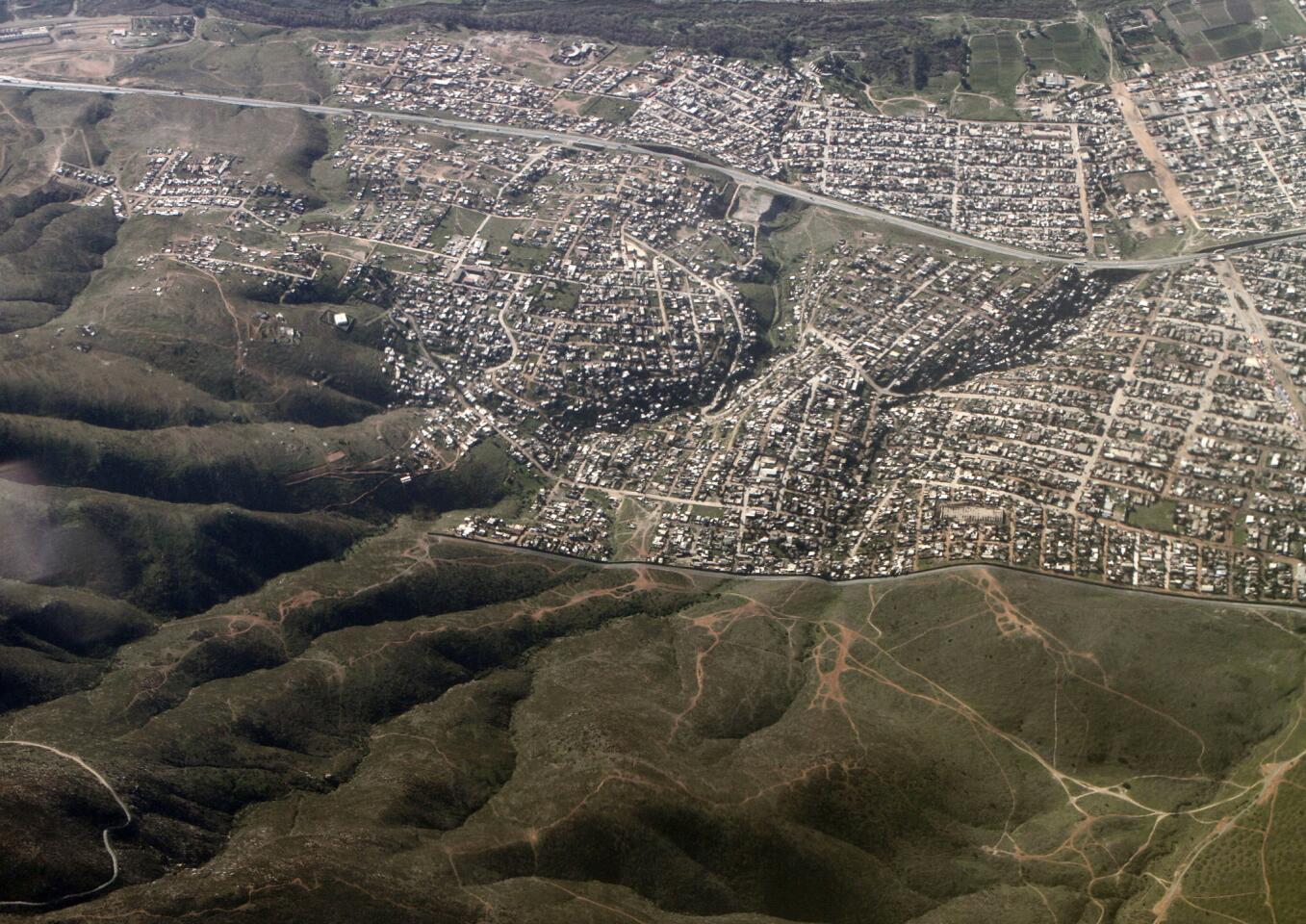
Feb. 22, 2013: This aerial photograph looks south at the U.S.-Mexico border. The border fence stops at the eastern edge of Tijuana’s Colonia Nido de las Aguilas neighborhood. The green expanse at the bottom is the Otay County (San Diego) Open Space Preserve. The Tijuana-Tecate toll road crosses the top of the photo. (Don Bartletti / Los Angeles Times)
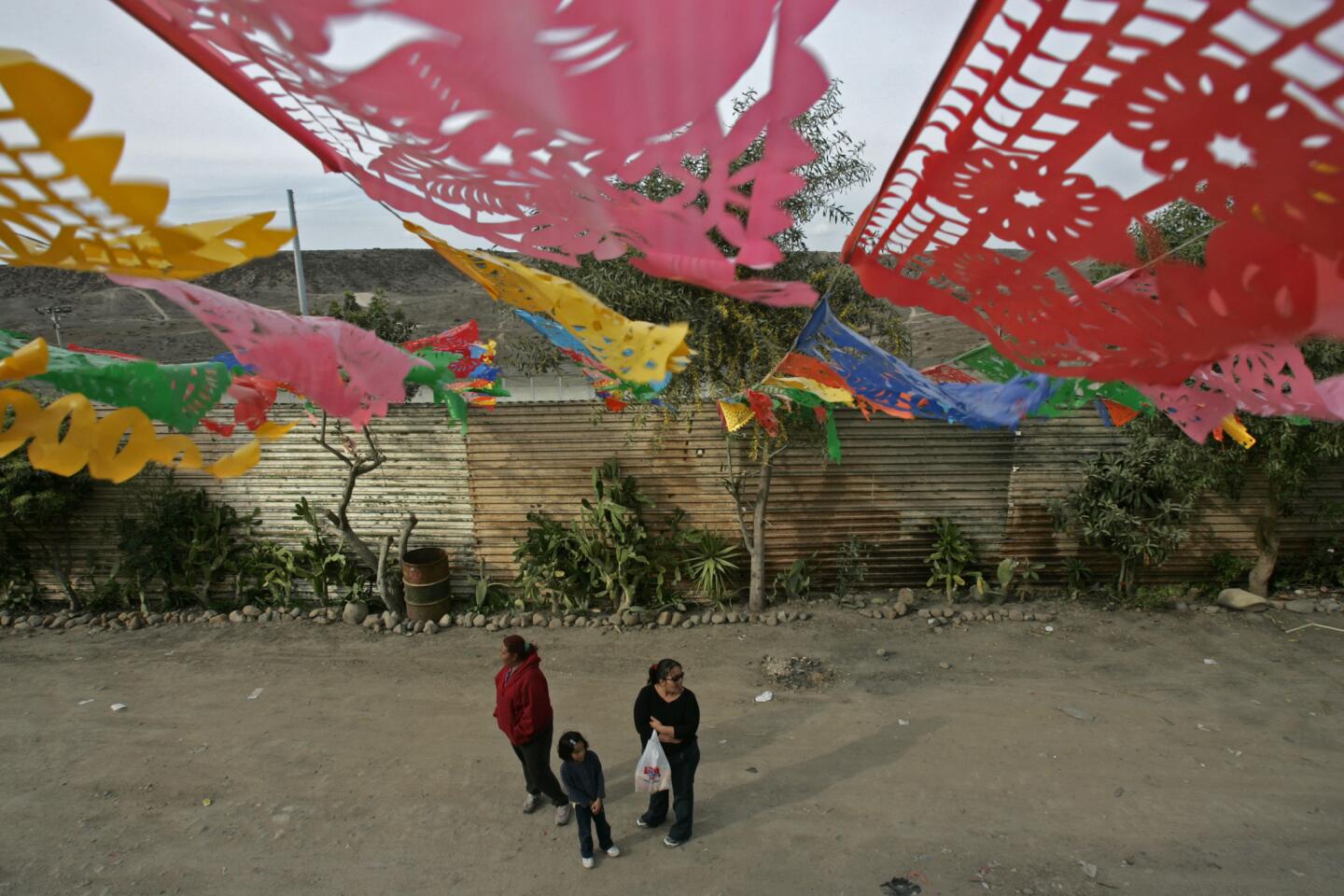
Feb. 16, 2006: Locals congregate in Tijuana’s Colonia Libertad, where the rusty 10-foot-high steel fence from the 1980s marks the border with the United States. Beyond it is a 15-foot-high secondary fence. Colorful plastic bunting stretches from Angelina Torrez’s front porch to the top of the barrier. (Don Bartletti / Los Angeles Times)
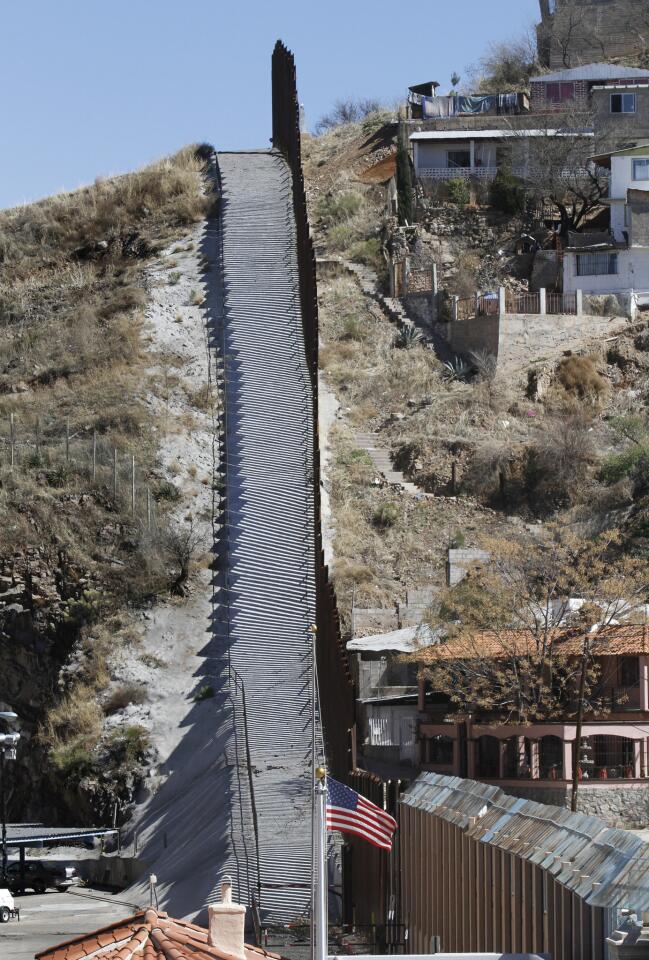
Feb. 26, 2013: Shadows from 15-foot-high steel pickets fall on the concrete base where the U.S.-Mexico border fence climbs a hill east of the Nogales, Ariz., Port of Entry. Nogales, Mexico, is on the right. (Don Bartletti / Los Angeles Times)
Advertisement
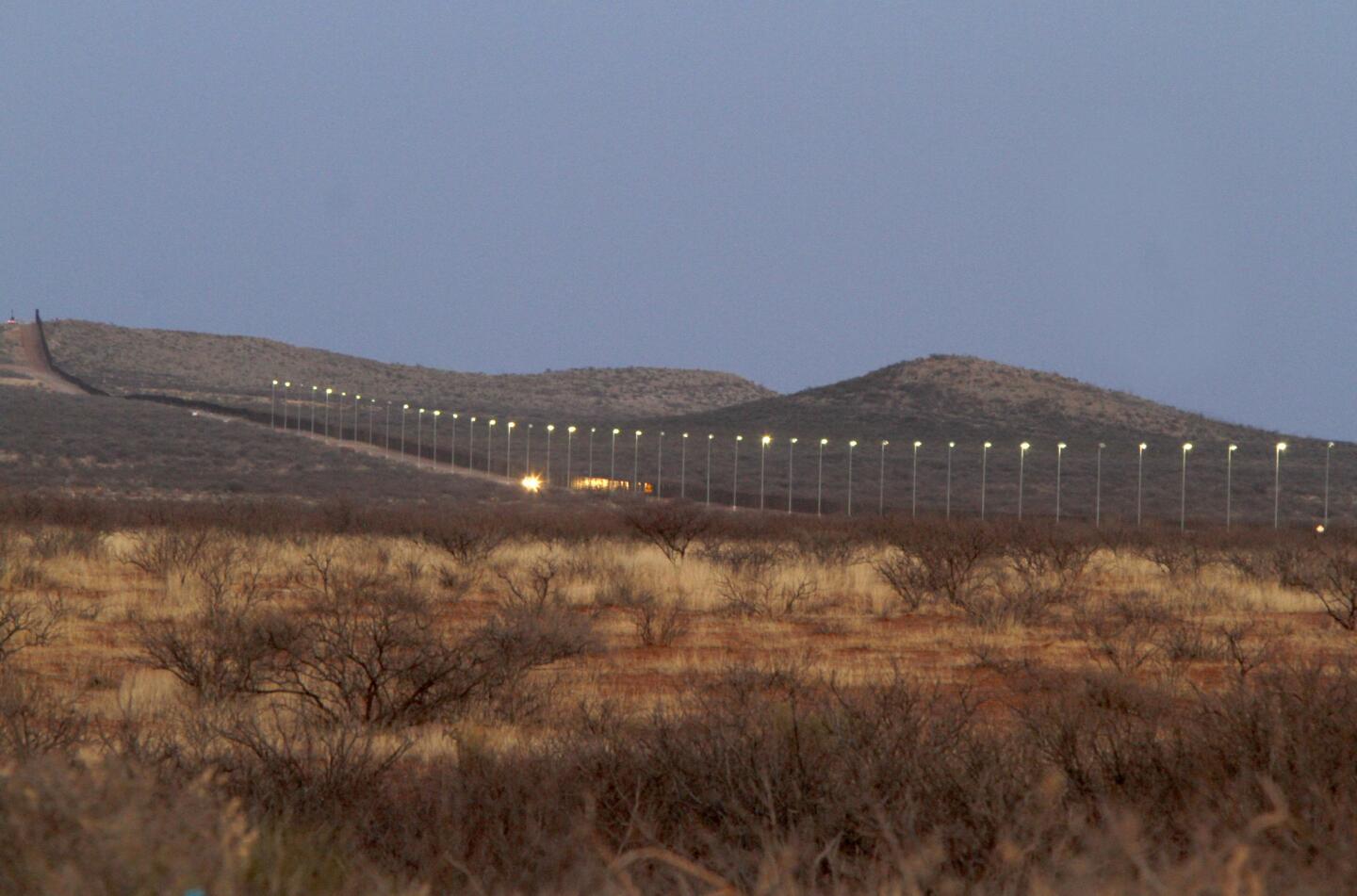
Feb. 24, 2013: A night view looking east at the U.S.-Mexico border fence in Naco, Ariz. Pole-mounted floodlights illuminate the fence from dusk to dawn. The dirt road at the base of the barrier is named International Highway but is restricted to Border Patrol use. (Don Bartletti / Los Angeles Times)
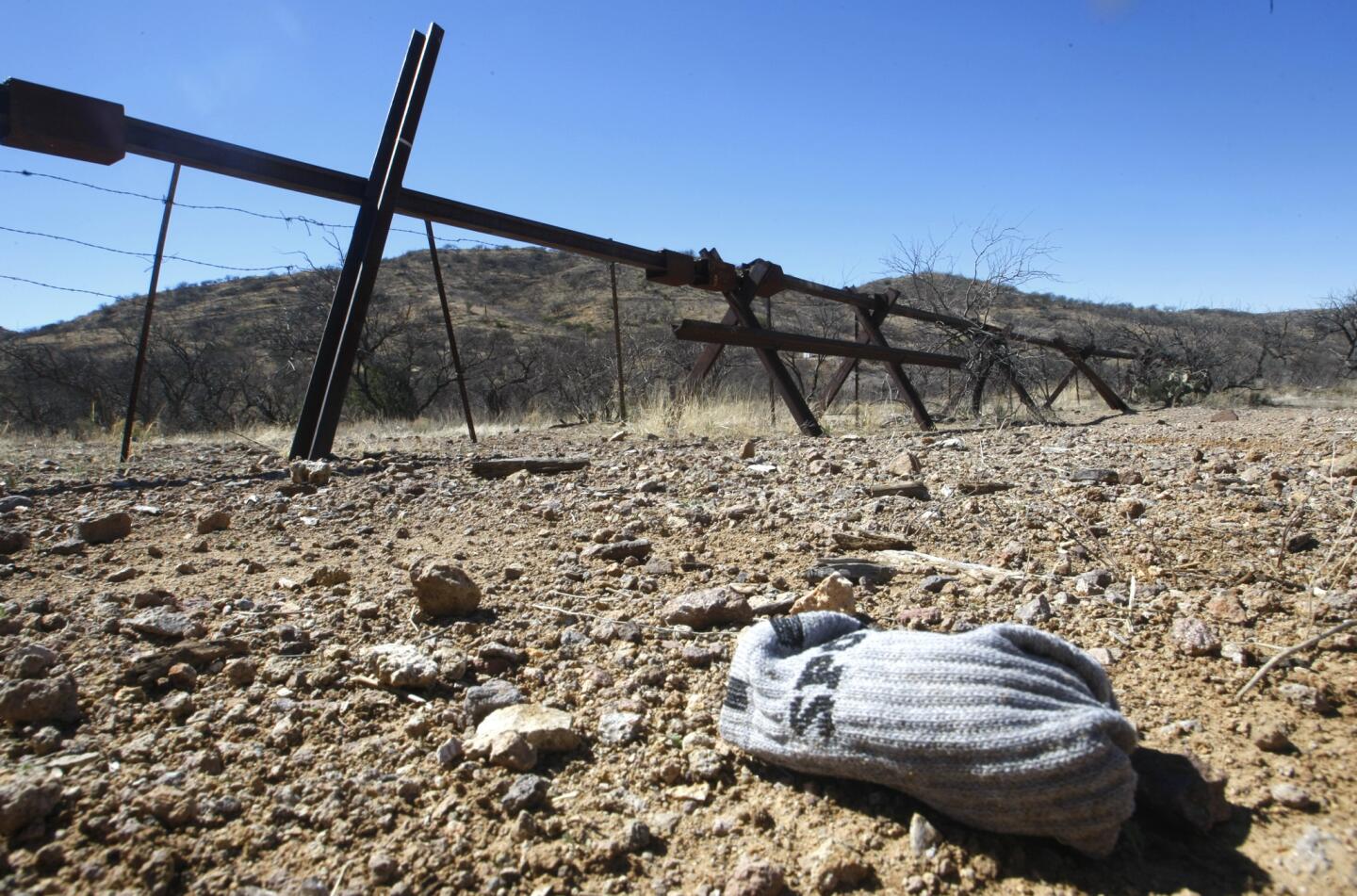
Feb. 23, 2013: A Normandy-style barrier marks the boundary of Sonora, Mexico, and the Chilton cattle ranch in Arivaca, Ariz. Made of steel railroad rails, it serves to stop smugglers from illegally driving north into Arizona. A bundled pair of clean socks was probably dropped by one of the many illegal immigrants who regularly walk north into the United States through the ranch. (Don Bartletti / Los Angeles Times)
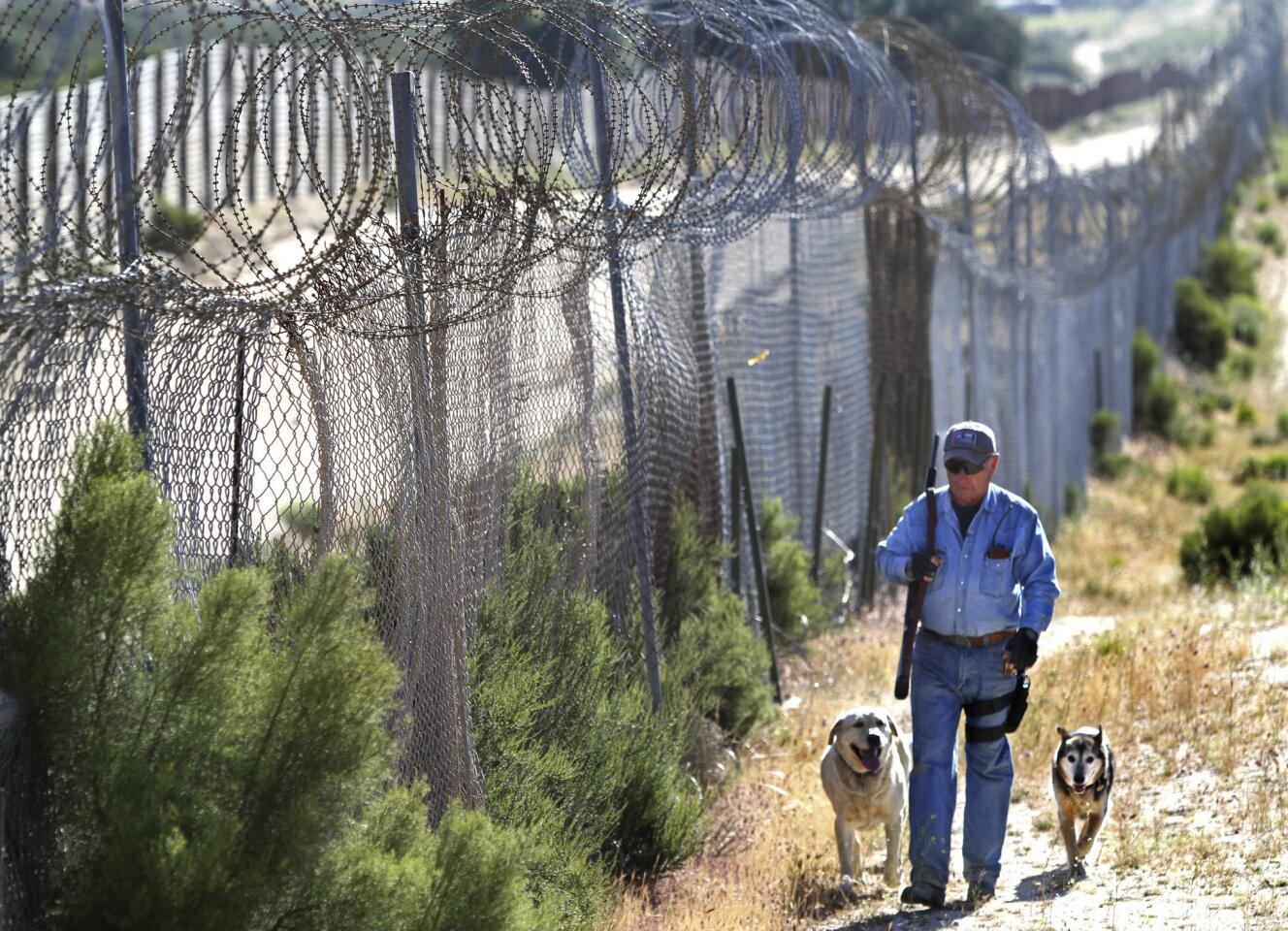
May 27, 2010: With a rifle slung over his shoulder and a pistol at his hip, Bob Maupin, 70, patrols his property in Tierra Del Sol, Calif., right on the U.S.-Mexico border. When his place became a major route for illegal immigrants and drug smugglers, he added chain link and razor wire. Since the Border Patrol erected an even higher steel fence nearby and boosted staffing, he says, “...there’s nobody walking on my place except me and the cows.” (Don Bartletti / Los Angeles Times)
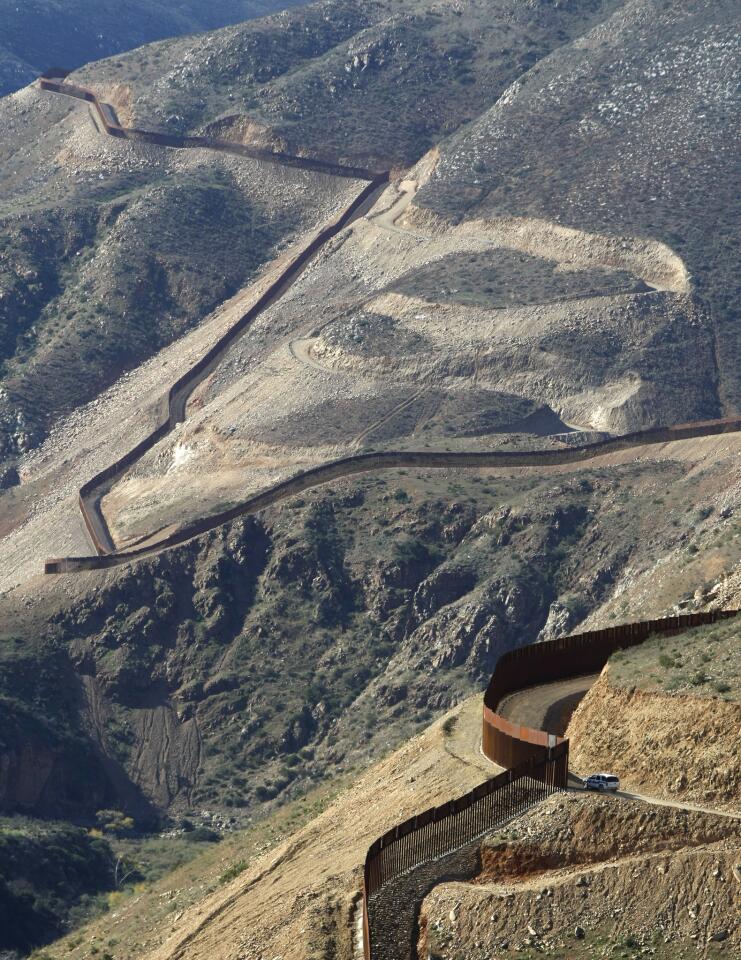
Jan. 11, 2010: A U.S. Border Patrol vehicle is parked near a zigzagging stretch of fence east of San Diego. (Don Bartletti / Los Angeles Times)
Advertisement
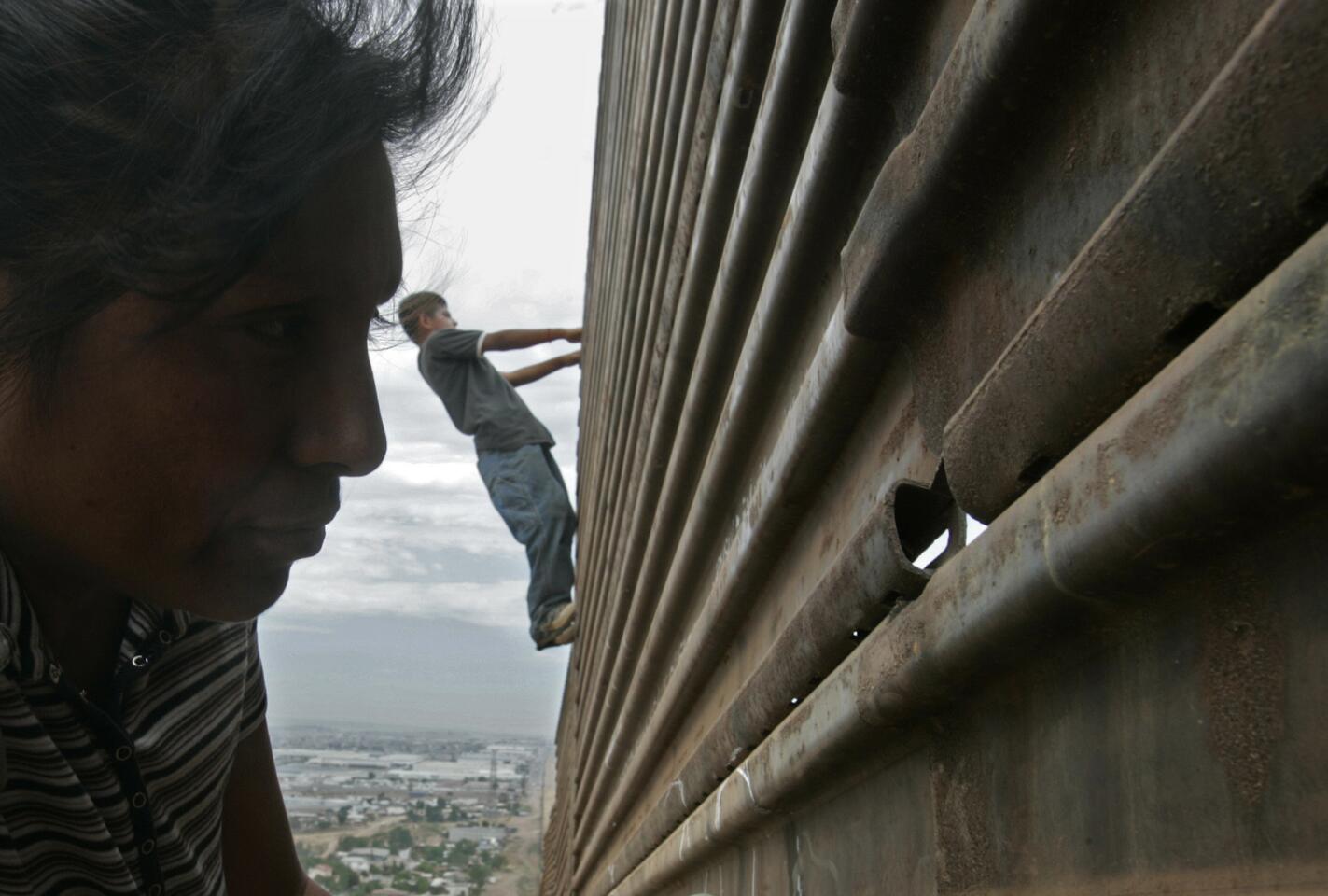
June 27, 2006: Much of the original border fencing, including this stretch in Tijuana, was easily scaled by migrants and was eventually replaced or reinforced. (Don Bartletti / Los Angeles Times)
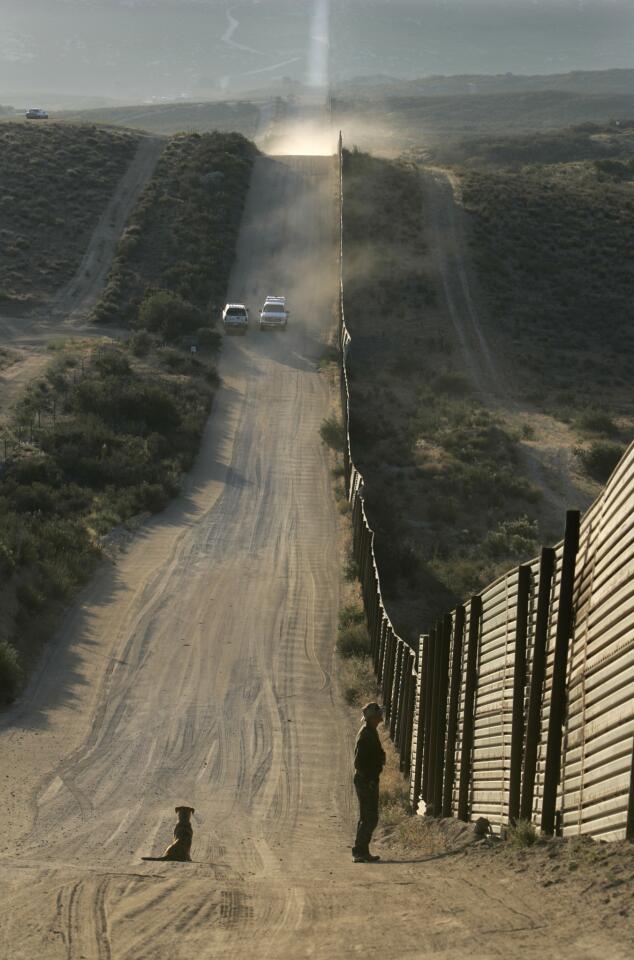
May 27, 2007: In the early morning, a Minutemen member and his dog retrieve a motion sensor placed near a hole dug beneath the 10-foot-high steel boundary fence at Campo, Calif., on the U.S.-Mexico border. A Border Patrol trucks kick up dust in the distance. (Don Bartletti / Los Angeles Times)







